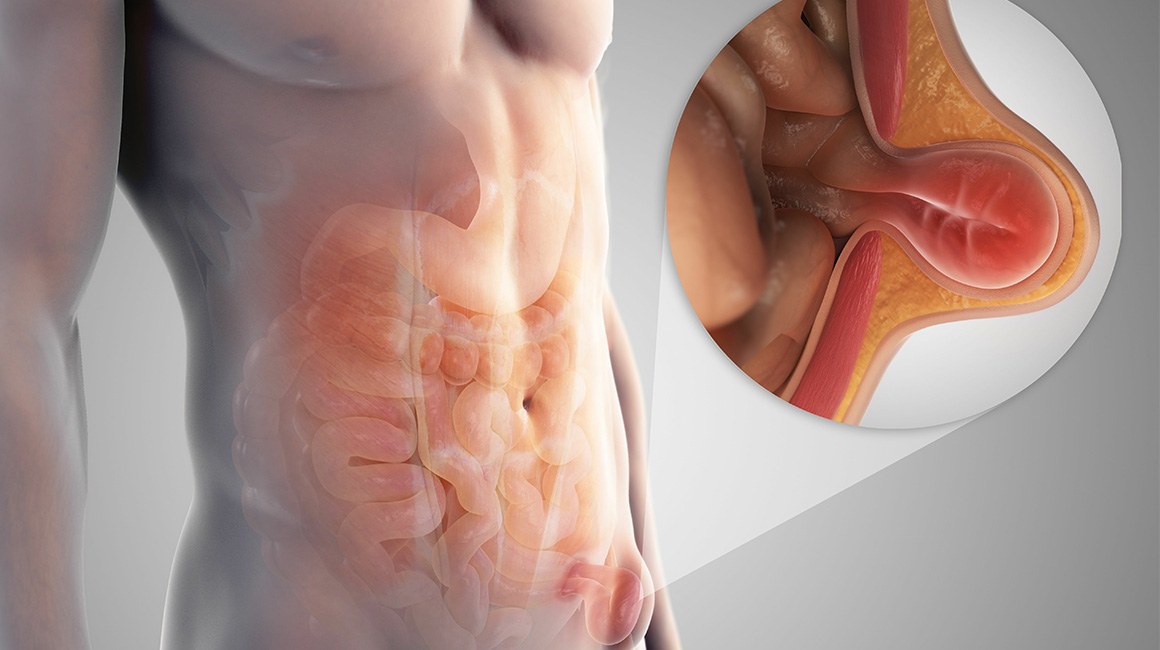Inguinal hernia is the prolapse of part of an intra-abdominal viscera (usually the small intestine or preperitoneal fat), which occurs between the thigh and the hypogastrium and more precisely in the area of the right or left inguinal canal. It is the most well-known form of hernia and one of the most common surgical conditions
Inguinal hernia occurs much more often in men than in women. It can occur at any age and is either congenital (from birth) or acquired (occurs growing up).
Most inguinal hernias are due to congenital causes, such as e.g. wide internal inguinal canal or disruption of collagen connective tissue function in the area.
Among the acquired causes of inguinal hernia, the most common is the increased intra-abdominal pressure, which develops from obesity, intense cough, constipation, prostate hypertrophy, heavy physical exercise, lifting heavy objects, pregnancy, etc.
The diagnosis of inguinal hernia is a simple matter, because its typical symptoms are easily identified and made by clinical examination of the patient. Usually a local swelling develops in the inguinal area with the appearance of pain, sometimes mild and sometimes more intense, which is aggravated by laughing, coughing or during exercise. Rarely, only pain without local swelling occurs. In doubtful cases, it is helpful to check the area with ultrasound, CT or MRI.
When the inguinal hernia is diagnosed, it must soon be treated appropriately, since in no case can it be repaired on its own, it worsens with time and there is a risk of “constriction”. The specialist surgeon will judge whether the inguinal hernia is “reducible”, i.e. reversible, or “irreducible”. In fact, in some cases it is possible for the doctor, or even the patient himself, to return the contents of the hernia to its correct position in the abdomen, in which case the hernia disappears, but always temporarily. The problem is not solved permanently, because it is very likely to appear worse again and even with an increased risk of constriction. Constriction is a condition of defective perfusion of the area, which can lead to necrosis of the outgoing organ (intestine) and endanger even the life of the patient. In this case urgent surgical treatment is required.
Irreducible inguinal hernia means that it cannot be reduced with manipulations and therefore a short and scheduled inguinal hernia repair must definitely follow.
Patients should be aware that:
- Inguinal hernia is due to mechanical causes, so it NEVER subsides or does not regress on its own, but ALWAYS has a progressively deteriorating development.
- Treatment is ONLY surgical. There is no drug treatment; on the contrary, painkillers “cover” the problem, making the hernia even more dangerous. Also, the bandages should not be used, because they make the surgery difficult, since after some time they weaken the abdominal walls or create adhesions.
- In case of constriction, the surgery changes character and from a simple operation turns into a much more complex surgery, which may even require resection of the dead intestine. Thus, the patient who neglected his hernia will be hospitalized with many risks for several days as opposed to one day hospitalization in a simple hernia.
- Therefore, surgery to repair a hernia is preventative, in order to prevent complications of the disease.
Surgical repair of the inguinal hernia means to surgically ensure its reduction and to follow the appropriate closure of the opening (gap) of the abdominal wall that allowed the exit of the intestine (organ) from the abdomen, so that the hernia does not reappear. The use of special synthetic meshes, very friendly to the tissues of the area and without their existence being felt afterwards within the body has become universally accepted nowadays for the safe and permanent closing of the opening.
In addition to open surgeries, laparoscopic surgeries (TEP or TAP) are used in recent years to repair inguinal hernia, by specially trained surgeons with very good results, faster recovery and return of the patient to work.
Surgical repair of the hernia can be done with local anesthesia. The operation is performed with a very small incision of 3-4 cm in the hairy pubes, which is not recognized after the surgery. The same day the patient returns home, while he can fully return to normal activities and work within a few days.
As with any surgery, there could theoretically be complications and a risk of infection, bleeding, nerve damage, venous thrombosis, or recurrence (re-appearance of the hernia). However, the recurrence rate is relatively small and varies depending on the surgeon's method and experience. Hernia repair by an experienced surgeon using modern invasive methods is a safe surgery.
 English
English  Ελληνικά
Ελληνικά 

